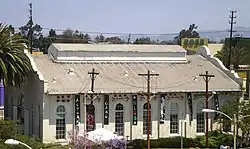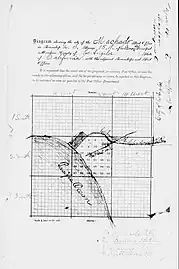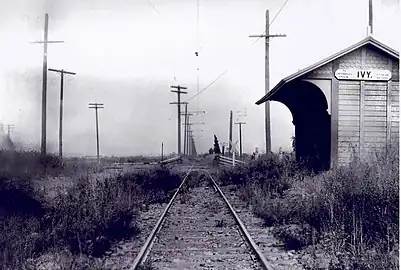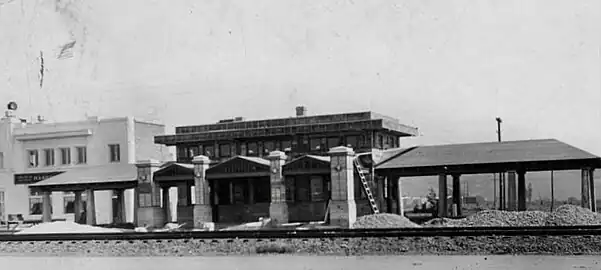Culver City station
Culver City station is an elevated light rail station on the E Line of the Los Angeles Metro Rail system. The station is located on a dedicated right-of-way alongside Exposition Boulevard — between the intersection of Venice Boulevard and Robertson Boulevard on the west and the intersection of Washington Boulevard and National Boulevard on the east. The station is located in the city of Culver City, California, after which the station is named.[4] The station served as the western terminus of the line from its opening on June 20, 2012, until the opening of the extension of the line to Santa Monica on May 20, 2016.
Culver City | ||||||||||||||||||||||
|---|---|---|---|---|---|---|---|---|---|---|---|---|---|---|---|---|---|---|---|---|---|---|
 Culver City station platform | ||||||||||||||||||||||
| General information | ||||||||||||||||||||||
| Location | 8817 Washington Boulevard Culver City, California | |||||||||||||||||||||
| Coordinates | 34.0282°N 118.3883°W | |||||||||||||||||||||
| Owned by | Los Angeles County Metropolitan Transportation Authority | |||||||||||||||||||||
| Platforms | 1 island platform | |||||||||||||||||||||
| Tracks | 2 | |||||||||||||||||||||
| Connections | ||||||||||||||||||||||
| Construction | ||||||||||||||||||||||
| Structure type | Elevated | |||||||||||||||||||||
| Parking | 586 spaces[1] | |||||||||||||||||||||
| Bicycle facilities | Metro Bike Hub, racks and lockers[2] | |||||||||||||||||||||
| Accessible | Yes | |||||||||||||||||||||
| History | ||||||||||||||||||||||
| Opened | October 17, 1875 | |||||||||||||||||||||
| Rebuilt | June 20, 2012[3] | |||||||||||||||||||||
| Previous names | Culver Junction; Ivy | |||||||||||||||||||||
| Services | ||||||||||||||||||||||
| ||||||||||||||||||||||
| ||||||||||||||||||||||
| Location | ||||||||||||||||||||||
History
A railway stop known as La Ballona Station, along the Los Angeles and Independence Railway established 1874, was located on or near the site of what came to be known as Ivy Station, Culver Junction and Culver City station.[5] La Ballona Station was located at what is now Washington Boulevard, which circa 1883 was known as the "Monte Vista and La Ballona Station Road" and which extended Washington Street west from Los Angeles.[6] In 1886, the "surveyors of the Santa Monica Railroad have just crossed the S.P. track at Ballona, just where the county road crossed that track near La Ballona station. The terminus is finally fixed at South Santa Monica, near where the old Juan Bernard wharf is."[7] When the Palms Depot opened in 1887 it was noted to be between La Ballona Station and Santa Monica.[8] The name La Ballona Station was still in use as late as 1893;[9] the name Ivy Station first appears in print in 1889.[10]
Los Angeles-Pacific Railroad built the Venice Short Line though the area in 1903.[11] The interurban railway was grade-separated from the steam railroad via an underpass. When The LAP began running cars over the Santa Monica Air Line in 1908, the tracks were connected to allow interchanges.[12] The point was later renamed Culver Junction to reflect its new role.
The Venice line closed in September 1950, making it no longer a junction; finally, all passenger service ended on September 30, 1953. The name "Culver Junction" remained on maps, referring to the immediate surrounding area. With service restoration along the corridor in June 2012, the new light rail station was named Culver City.
Ivy Substation, a traction substation building which housed mechanical rotary converters used to supply DC current to the line until 1953, is still standing near this station and has been converted into the popular Actor's Gang Theater. (Train power now comes from a much smaller building beneath the elevated platform.)
Service
Station layout
| Platform | Westbound | ← |
| Island platform, doors will open on the left | ||
| Eastbound | | |
| G | Street Level | Entrance/Exit, faregates, ticket machines |
Hours and frequency
E Line trains run every day between approximately 4:30 a.m. and 12:30 am. Trains operate every ten minutes during peak hours Monday through Friday, every twelve minutes during the daytime on weekdays and all day on the weekends after approximately 8 a.m. (with 15 to 20-minute headways early Saturday and Sunday mornings). Night service is every 20 minutes.[13]
Connections
As of June 16, 2023, the following connections are available:[14][15]
- Big Blue Bus (Santa Monica): Rapid 12
- Culver CityBus: 1, 7
- LADOT Commuter Express: 437
- Los Angeles Metro Bus: 33, 617
Notable places nearby

At the northeast edge of Downtown Culver City, a major retail, entertainment and arts district, the station is within walking distance of several notable places:
- Helms Bakery
- Ballona Creek Bike Path
- Hayden Tract
- Museum of Jurassic Technology
- Kirk Douglas Theater
- Ivy Substation (a former power building for this station)
- Ivy Station (apartments, retail, a hotel, and the west coast headquarters of HBO)[16]
Station artwork
The station's art was created by artist Tom LaDuke. Entitled Unknowable Origins, the installation depicts softly rendered views of Culver City as seen from surrounding hillside viewpoints, with abstracted face shapes of notable people from Culver City appearing in each panel.[17]
Additional images
 During the Los Angeles and Independence Railway era, the stop was known as La Ballona Station (U.S. National Archives; map attached to 1878 application for Machado post office between Los Angeles and Santa Monica)
During the Los Angeles and Independence Railway era, the stop was known as La Ballona Station (U.S. National Archives; map attached to 1878 application for Machado post office between Los Angeles and Santa Monica) Ivy station c. 1905, looking west
Ivy station c. 1905, looking west
 Culver City depot under construction circa 1923; per the Los Angeles Public Library's photo catalog description, the white building to the rear is Harry Culver's real estate office (Los Angeles Herald Examiner Photo Collection)
Culver City depot under construction circa 1923; per the Los Angeles Public Library's photo catalog description, the white building to the rear is Harry Culver's real estate office (Los Angeles Herald Examiner Photo Collection) E Line (Los Angeles Metro) platform at Culver City station, 2015
E Line (Los Angeles Metro) platform at Culver City station, 2015
References
- "Metro Parking Lots by Line". Los Angeles County Metropolitan Transportation Authority. Archived from the original on August 10, 2020. Retrieved November 5, 2021.
- "Secure Bike Parking on Metro" (PDF). Los Angeles County Metropolitan Transportation Authority. Archived from the original (PDF) on September 6, 2021. Retrieved November 5, 2021.
- "Two more Expo Line stations to open June 20". Los Angeles Times. June 5, 2012. Archived from the original on January 10, 2022. Retrieved January 10, 2022.
- "Exposition Bl/Culver City Connections" (PDF). Metro. July 2012. Archived from the original (PDF) on September 1, 2012. Retrieved January 8, 2022.
- "Record Group 28: Records of the Post Office Department, Series: Reports of Site Locations, California: Los Angeles M - Z (NAID: 68228967)". catalog.archives.gov. Archived from the original on March 11, 2023. Retrieved March 11, 2023.
- "Los Angeles Herald 10 May 1883, page Page 3". Newspapers.com. Archived from the original on March 11, 2023. Retrieved March 11, 2023.
- "Los Angeles Herald 14 Mar 1886, page Page 1". Newspapers.com. Archived from the original on March 11, 2023. Retrieved March 11, 2023.
- "Los Angeles Herald 15 Jan 1887, page Page 8". Newspapers.com. Archived from the original on March 11, 2023. Retrieved March 11, 2023.
- "Los Angeles Herald 10 Jan 1893, page Page 8". Newspapers.com. Archived from the original on March 11, 2023. Retrieved March 11, 2023.
- "The Los Angeles Times 02 Jun 1889, page 1". Newspapers.com. Archived from the original on March 11, 2023. Retrieved March 11, 2023.
- Masters, Nathan (February 21, 2014). "Many L.A. Boulevards Began as Trolley Lines". KCET. Archived from the original on February 14, 2021. Retrieved February 7, 2021.
- "Electric Line to Beach Displaces S.P. Railroad". Los Angeles Evening Express. May 16, 1908. p. 5. Archived from the original on September 14, 2022. Retrieved July 28, 2022 – via Newspapers.com.

- "Metro E Line schedule". Los Angeles County Metropolitan Transportation Authority. September 12, 2021. Archived from the original on November 20, 2021. Retrieved November 13, 2021.
- "E Line Timetable – Connections section" (PDF). Los Angeles County Metropolitan Transportation Authority. June 16, 2023. p. 2. Retrieved June 26, 2023.
- "Little Blue Book" (PDF). Big Blue Bus (Santa Monica). January 15, 2023. Retrieved June 26, 2023.
- Sharp, Steven (April 6, 2020). "Exterior Finishes Unveiled at Culver City's Ivy Station Complex". Urbanize LA. Archived from the original on April 7, 2020. Retrieved April 7, 2020.
- "Unknowable Origins". Metro Art. Archived from the original on January 26, 2022. Retrieved December 7, 2021.
- Electric Railway Historical Association of Southern California, Pacific Electric, accessed January 2008
- Electric Railway Historical Association of Southern California, A Chronology of Changes in Rail Passenger Operations of the Pacific Electric Railway Company, accessed January 2008
- Line names mostly come from the McGraw Transit Directory, 1920, p. 11.
External links
![]() Media related to Culver City (Los Angeles Metro station) at Wikimedia Commons
Media related to Culver City (Los Angeles Metro station) at Wikimedia Commons